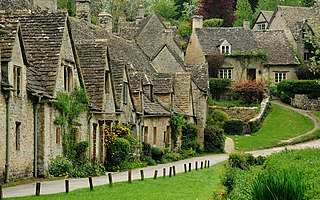
Gloucestershire is a ceremonial county in South West England. It is bordered by Herefordshire to the north-west, Worcestershire to the north, Warwickshire to the north-east, Oxfordshire to the east, Wiltshire to the south, Bristol and Somerset to the south-west, and the Welsh county of Monmouthshire to the west. The city of Gloucester is the largest settlement and the county town.

The Herefordshire and Gloucestershire Canal is a canal in the west of England, which ran from Hereford to Gloucester, where it linked to the River Severn. It was opened in two phases in 1798 and 1845, and closed in 1881, when the southern section was used for the course of the Ledbury and Gloucester Railway. It is the subject of an active restoration scheme.
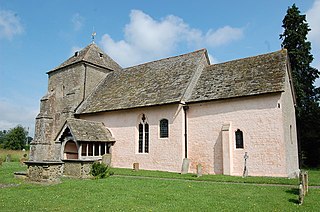
Kempley is a village and civil parish in the Forest of Dean district of Gloucestershire, England, close to the border with Herefordshire. It lies 17 miles (27 km) northwest of Gloucester and 17 miles (27 km) of Hereford. The nearest market towns of Newent and Ledbury are 5 miles (8.0 km) and 8 miles (13 km) away respectively.

Ledbury is a market town and civil parish in the county of Herefordshire, England, lying east of Hereford, and west of the Malvern Hills.

Newent is a market town and civil parish in the Forest of Dean in Gloucestershire, England. The town is 11 miles (18 km) north-west of Gloucester. Its population was 5,073 at the 2001 census, rising to 5,207 in 2011, The population was 6,777 at the 2021 Census. Once a medieval market and fair town, its site had been settled at least since Roman times. The first written record of it appears in the 1086 Domesday Book.

Forest of Dean is a local government district in west Gloucestershire, England, named after the Forest of Dean. Its council is based in Coleford. Other towns and villages in the district include Blakeney, Cinderford, Drybrook, English Bicknor, Huntley, Littledean, Longhope, Lydbrook, Lydney, Mitcheldean, Newnham and Newent.

Newnham or Newnham on Severn is a village in west Gloucestershire, England. It lies in the Royal Forest of Dean, on the west bank of the River Severn, approximately 10 miles south-west of Gloucester and three miles southeast of Cinderford. It is on the A48 road between Gloucester and Chepstow, Monmouthshire, Wales. The village has a parish council.

Tidenham is a village and civil parish in the Forest of Dean of west Gloucestershire, England, adjoining the Welsh border. Tidenham is bounded by the River Wye to the west and the River Severn to the south. Offa's Dyke runs through the western part of the parish, terminating at Sedbury cliff above the River Severn.

Mitcheldean is a market town in the Forest of Dean in Gloucestershire, England.

The Ledbury and Gloucester Railway,, was a railway line in Herefordshire and Gloucestershire, England, running between Ledbury and Gloucester. It opened in 1885 and closed in 1964.
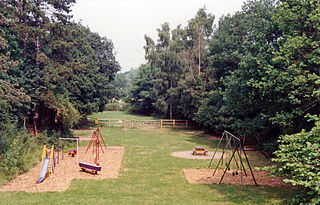
Dymock railway station was a stop on the former Ledbury and Gloucester Railway. It opened in 1885 and served the Gloucestershire village of Dymock. It was closed for passengers in 1959 but remained open for freight traffic until 1964 when the line was closed.

Newent railway station served the town of Newent in Gloucestershire, England.

The River Leadon is a river in Herefordshire and Gloucestershire, England, a tributary of the River Severn. It rises just south of the village of Acton Beauchamp, and flows south past Bosbury to the town of Ledbury, which takes its name from the river. It then flows south and east past Dymock, Upleadon and Highleadon to join the Severn at Over, just west of Gloucester. The river is approximately 32 miles (51 km) long.

Hereford Road Skew Bridge is a disused railway bridge in Ledbury, Herefordshire. Built in 1881 to carry the Ledbury and Gloucester Railway across the Hereford Road at an angle of approximately 45°, it was built as a ribbed skew arch with stone spandrels and wing walls, and ribs of blue brick. The railway line was closed in 1959 and the bridge is now used as part of the Ledbury Town Trail footpath.

Kempley Daffodil Meadow is a 1.2-hectare (3.0-acre) biological Site of Special Scientific Interest in Gloucestershire, notified in 1986.
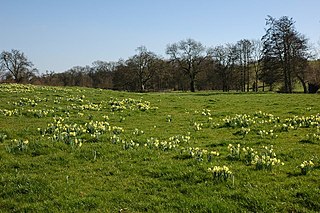
Ketford Bank is a 0.69-hectare (1.7-acre) nature reserve in Gloucestershire.

Canon John Eric Gethyn-Jones MBE FSA was a clergyman and historian of Gloucestershire. He served in the Royal Army Chaplains' Department during the Second World War for which he was awarded the MBE in 1945. Later he was vicar of St Mary of the Virgin's Church, Berkeley, and rose to the position of Canon. He wrote a number of works including books on the history of Dymock and Berkeley, Gloucestershire.

St Mary's Church, Dymock is a Church of England parish church in the center of the village of Dymock in Gloucestershire, England. It is a Grade I listed building.
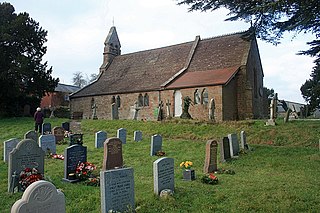
Preston is a village, former manor, civil and ecclesiastical parish in the Forest of Dean in Gloucestershire, England. It is situated 22 km north-west of the city of Gloucester and 4 km south-west of the Herefordshire town of Ledbury. In 1931 the parish had a population of 77. On 1 April 1935 the parish of Preston, comprising 897 acres, was added to the parish of Dymock, adjacent at the south-east, the parish church of which, St Mary the Virgin, is situated 4 miles to the south-east.

Oxenhall is a village and civil parish 10 miles (16 km) north west of Gloucester, in the Forest of Dean district, in the county of Gloucestershire, England. In 2011 the parish had a population of 243. The parish touches Dymock, Gorsley and Kilcot, Kempley, Newent and Upton Bishop. Oxenhall has a parish meeting.






















